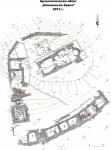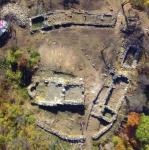Summary (English)
URVICH FORTRESS (Boni Petrunova – boni_boon@abv.bg, Elena Vasileva) The explorations of the monastery comlex, which was founded at the end of the 14th century and was situated in the central part of the fortress, continued. A layer containing fragmentary building ceramics, mortar and frescoes was discovered in front of St. Elias Church. The pavement of stone slabs was discovered in the refectory (Room No. 4) and an earlier pavement of stone slabs was documented beneath. Sherds and fragmentary building ceramics of the 15th – 17th centuries were found. Three monk cells (Rooms Nos. 5, 6 and 7), the monastery passage, 5.30 m long, 1.90 m wide and paved with slabs, Room No. 8 and the surrounding monastery wall 90 cm wide, were discovered. The rooms were built of roughly-cut stones bonded with mortar. Fragmentary building ceramics, iron nails and wedges from the roof, sherds from glazed and sgraffito pottery and coins of the Ottoman period were found. Sherds of the Ottoman period, burned pieces of timber beams and animal bones were found in front of Rooms Nos. 5 and 6. The finds from the excavations included a Thracian bronze bracelet and a bronze arrowhead of the 5th – 3rd century BC, 40 Late Antique coins of Theodosius II, Valentinian III, Marcian and Leo I the Thracian, including a gold solidus of Marcian, Early Byzantine coins of Anastasius I Dicorus, Justinian I and Justin II, three exagia of the 4th – 6th centuries AD, two coins of the Bulgarian King Ivan Sratsimir, including a silver aspra, 14 Ottoman coins of the 15th – 17th centuries (the earliest one was a silver akçe of Sultan Murad II minted in 1430 in Edirne), including a silver akçe of the Crimean Khanate minted in the 1640s, and a finger-ring with an open-work cross-like decoration.
- Boni Petrunova - National Museum of History
- Elena Vasileva - Archaeological Institute with Museum
Director
Team
Research Body
- Archaeological Institute with Museum






![Download [PDF]](/excavation/skins/fasti/images/results/download_sml.png)

